Chiang Saen
Once one of the major cities of the Lanna kingdom, it was originally called Wiang Hiran Nakhon Ngoen Yang and served as the capital before King Mengrai established Chiang Rai in 1262. The town was captured by the Burmese in the 16th century and sacked by King Rama I in 1803. Left a ghost town for a hundred years, it was repopulated around 1900, but still hasn’t really staggered to its feet. Traces of old double city walls and many other antiquities still remain in and outside the district town Chiang Saen is connected by local bus to Chiang Rai (2 – 2.5 hrs, nominally 3-4 per hour but tend to depart when reasonably full, 37 baht). There are a few 3-4 /day long distance buses which can do the trip in 1.5 hrs but times are more convenient for long distance journeys such as going to or from Chiang Mai or Bangkok than for commuting to Chang Rai. Blue songthaews also travel from Mae Sai via the Golden Triangle to Chiang Saen in about 1 hour (50 baht) . The timetable for this service is chalked up at the depot which is next to the bus stop. These seem to depart every half hour or so. The service from the Golden Triange to Chiang Sen seems to be much more irregular. Whilst aspiring to a timetable this service varies with available customers and the flow of life along the Mekong and the Myanmar border. The bus station and songthaew depot is located about 50 meters before the main road (Highway 1016) ends in a T-intersection on the banks of the Mekong river (intersection pictured above). There does not appear to be any regular public transport south to Chiang Khong and the Lao border crossing, apart from the occasional blue-green songthaews that line up south of the intersection in front of Wat Pong Sanuk. One must ask locally for details of this service as departures times do vary By car The district can be reached by taking Highway No. 110 from Chiang Rai for some 30 kilometres. Then take a right turn onto Highway No. 1016 and proceed on for another 30 kilometres. By boat It’s also possible to charter a boat carrying up to 8 people along the Mekong to Chiang Khong (1.5 hrs) for around 1500 baht, or up to Sop Ruak (Golden Triangle) for less (around 40 min). Sightseens: Like Chiang Mai, Chiang Saen has a city wall surrounding the historic town, but the fourth “wall” is formed by the Mekong River. Chiang Saen National Museum. Where knowledge can be sought concerning archaeology, settlements and history of the town. There are replicas of the community and scores of ancient relics including Lanna-style sculptures, Buddha statues and inscription stones from Phayao and Chiang Saen itself. In addition, there are exhibitions of indigenous art objects of the Thai Yai, Thai Lu and other hilltribes. These items include musical instruments, ornaments, opium-smoking accessories, etc. Open Wednesday-Sunday from 09.00-16.00 hrs. Wat Phra That Chedi Luang. Located in Chiang Saen old town, was built by King Saen Phu, the 3rd ruler of the Lanna kingdom in early 13th Century. Ancient sites include the bell-shaped, Lanna-style principal Chedi which measures 88 metres height with a base 24 metres width, is the largest structure in Chiang Saen. There are also remains of ancient Viharn and Chedi. Wat Phra Chao Lan Thong. Located within the city wall, built by Prince Thong Ngua, a son of King Tilokkarat, the 12th ruler of Lanna, in 1489. A 1,200-kilogram Buddha statue was cast, a lap 2 metres width and over 3 metres height, named “Phra Chao Lan Thong”. Another Buddha statue called “Phra Chao Thong Thip” was also cast which is made of brass in Sukhothai style. Wat Pa Sak about one kilometre to the west of Chiang Saen in Tambon Wiang, was built by King Saen Phu in 1295 and three hundred teak trees were planted, hence the name is Pa Sak (Teak Wood). It was then the residence of the patriarch. The temple’s chedi is beautiful in Chiang Saen architectural style and the exteriors are elaborately decorated with designs. The chedi itself measures 12.5 metres tall with a base of 8 metres width, enshrined the Lord’s Buddha relics. There are also several ancient sites outside the city wall including Wat Phra That Pha Ngao is a place for dharma practice, Wat Chedi Ched Tod is a peaceful place, located 1 km. further from Wat phra That Pha Ngao. Wat Phra That Chom Kitti about 1.7 kilometres from town, and Wat Sangkha Kaeo Don Han where sketches on brick slabs tell stories about the various lives of the Lord Buddha. Chiang Saen Lake is a large natural reservoir with scenic surroundings. Large flocks of waterfowls immigrate to the site during winter. Located 5 kilometres from the district on Highway no.1016, the Chiang Saen-Mae Chan route. Turn left at km.27 and proceed on for another 2 kilometres to reach the site. Wat Phra That Pha Ngao, about 4 kilometres from Chiang Saen on the road to Chiang Khong. There is a bell-shaped Chedi standing on large boulders. Nearby is a Viharn where several old Chiang Saen-style Buddha statues are enshrined. There is also a viewing point to enjoy scenery of the Mekong and of Chiang Saen itself.
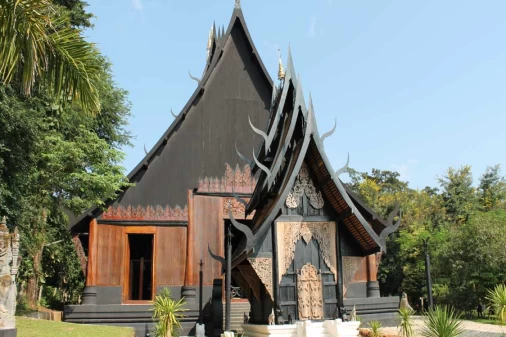
Baandam
Another of Chiang Rai’s more extraordinary sites, in a town that’s blessed with several rather eccentric...
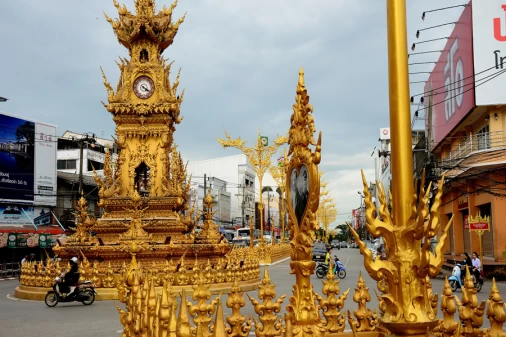
Clock Tower
When you look at all the travel guides and sites about Chiang Rai in Northern Thailand they always use...
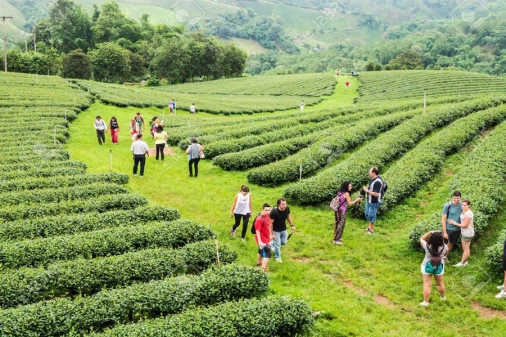
Doi Mae Salong
Mae Salong’s early history centred on the the opium trade of the Golden Triangle. Its recent history...
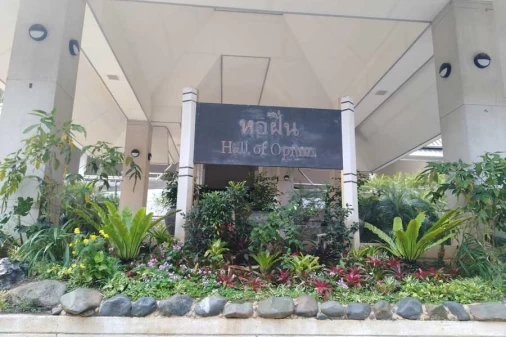
Hall of Opium
The Hall of Opium Museum is a combination of multimedia and exhibition to make learning more fun. Aiming...

Hill Tribe Museum
Hilltribe Museum and Education Centre is run by a nonprofit organization called the Population and Community...
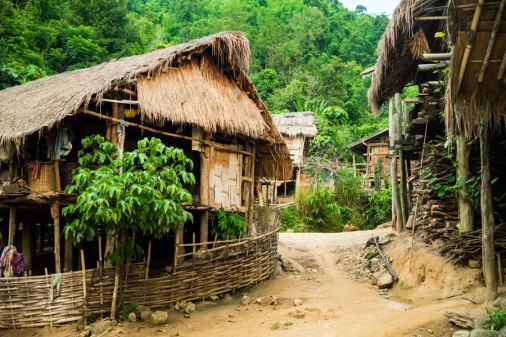
LaHu Village
Lahu people are to be found in the mountains of China, Myanmar (Burma), Laos and northern Thailand....
You may also like
The Best of Thailand 7 Days
- Depart Time:Daily
- Starts/Ends:Bangkok/Chiang Mai
- Tour type:Private Tours
- Travel Style:Nature & Adventure, Family Tours, Culture & History
- Activities:Sightseeing Tours, Local culture tours, Cultural, religious and historic sites tours, Countryside and village visits tours
- Suitable for:Solo, Family, Group, Couple
- Age range:1 To 90 Years
- Operated in:English, French, Spanish, German, Italian
Amazing Thailand 10 Days
- Depart Time:Daily
- Starts/Ends:Bangkok/Bangkok
- Tour type:Private Tours
- Travel Style:Nature & Adventure, Heritage Tours, Culture & History
- Activities:Sightseeing Tours, Local culture tours, Cultural, religious and historic sites tours, Countryside and village visits tours
- Suitable for:Solo, Family, Group, Couple
- Age range:1 To 90 Years
- Operated in:English, French, Spanish, German, Italian
Best of the North Thailand 11 Days
- Depart Time:Daily
- Starts/Ends:Bangkok/Chiang Mai
- Tour type:Private Tours
- Travel Style:Nature & Adventure, Family Tours, Culture & History
- Activities:Sightseeing Tours, Local culture tours, Cultural, religious and historic sites tours, Countryside and village visits tours
- Suitable for:Solo, Family, Group, Couple
- Age range:1 To 90 Years
- Operated in:English, French, Spanish, German, Italian
Romantic Thailand 13 Days
- Depart Time:Daily
- Starts/Ends:Bangkok/Bangkok
- Tour type:Private Tours
- Travel Style:Nature & Adventure, Family Tours, Culture & History
- Activities:Sightseeing Tours, Local culture tours, Cultural, religious and historic sites tours, Countryside and village visits tours
- Suitable for:Solo, Family, Group, Couple
- Age range:1 To 90 Years
- Operated in:English, French, Spanish, German, Italian
Thailand Family Holidays 14 Days
- Depart Time:Daily
- Starts/Ends:Bangkok/Bangkok
- Tour type:Private Tours
- Travel Style:Nature & Adventure, Family Tours, Culture & History
- Activities:Sightseeing Tours, Local culture tours, Cultural, religious and historic sites tours, City sightseeing tours
- Suitable for:Solo, Family, Group, Couple
- Age range:1 To 90 Years
- Operated in:English, French, Spanish, German, Italian
 France
France  Spain
Spain  German
German  Italian
Italian 






 Vietnam Tours
Vietnam Tours  Cambodia Tours
Cambodia Tours  Myanmar tours
Myanmar tours  Thailand Tours
Thailand Tours  Laos Tours
Laos Tours